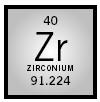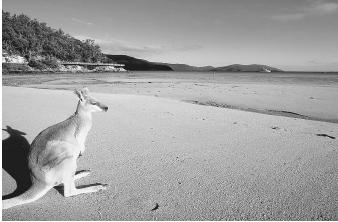Zirconium

MELTING POINT:
185°C
BOILING POINT:
4,375°C
DENSITY:
6.4 g/cm
3
MOST COMMON IONS:
Zr
4+
Zirconium was discovered by the German chemist Martin H. Klaproth in 1789. The principal ore of zirconium is zircon, which is widely distributed in nature as beach sands, particularly in Australia and India. Zirconium is the nineteenth most abundant element in the earth's crust (at approximately 0.03%). Zircon is a silicate of formula ZrSiO 4 and occurs as the gemstones hyacinth and zirconite. Synthetic gemstones are prepared from zircon and from the oxide ZrO 2 . Zirconium metal is difficult to produce. Its production requires treatment of the tetrachloride ZrCl 4 with magnesium metal. Zirconium metal is silvery-gray, ductile , and malleable.
Zirconium's major use is as cladding for nuclear reactors. It is ideal for this use, as it has a limited ability to capture neutrons, strength at elevated temperatures, considerable corrosion resistance, and satisfactory neutron damage resistance. Almost all ores of zirconium contain about 2 percent of zirconium's sister element, hafnium (Hf). Hafnium readily absorbs neutrons and therefore must be completely separated and removed from zirconium before either element can be used in nuclear reactors. A major task of the Manhattan Project was the separation of hafnium from zirconium. The elements are the two most chemically similar in the Periodic Table. The recovered hafnium metal is used to make the control rods of nuclear reactors, as the metal readily absorbs neutrons.
Zirconium oxide, or zirconia, occurs as the mineral baddeleyite, but zirconium oxide is obtained commercially mainly via its recovery from zircon. Zircon is treated with molten sodium hydroxide to dissolve the silica. Zirconia is used as a ceramic, but it must be doped with about 10 percent CaO or Y 2 O 3 to stabilize it in its face-centered cubic form. Zirconia is monoclinic , meaning that it has one oblique intersection of crystallographic axes, but it undergoes a phase change at about 1,100°C (2,012°F), its crystal structure becoming tetragonal, and above 2,300°C (4,172°F) it becomes cubic. To

prevent expansion and shrinkage across the 1,100°C phase change (which produces cracking), the stabilized form of zirconia is used, as it does not change phase until very high temperatures are reached. Stabilized zirconia is used to regulate the air-fuel mixtures in automobiles, as it is an oxide ion conductor . It generates an electric potential based on the amount of oxygen in the fuel and can adjust the mixture by electrical control of valves to ensure proper fuel burning.
The most important soluble compound of zirconium is zirconyl chloride, ZrOCl 2 ·8H 2 O, but this compound does not contain the zirconyl ion ZrO 2+ . It is a tetramer of composition [Zr(OH) 2 ·4H 2 O] 4 8+ , prone to polymerize to larger species as pH increases, forming hydrous zirconia, ZrO x (OH) y · n H 2 O. Other important soluble salts are the sulfate, Zr(SO 4 ) 2 ·4H 2 O, and the nitrate, Zr(NO 3 ) 4 ·5H 2 O, isolated from strongly acidic solutions. Both zirconium and titanium form organometallic compounds that are important catalysts in the conversion of ethylene to polyethylene.
SEE ALSO Hafnium ; Nuclear Chemistry ; Manhattan Project ; Organometallic Compounds .
Abraham Clearfield
Bibliography
Greenwood, N. N., and Earnshaw, A. (1985). Chemistry of the Elements. New York: Pergamon Press.
Stevens, R. (1986). Zirconia and Zirconia Ceramics, 2nd edition. Twickenham: Magnesium Elektron, Inc.